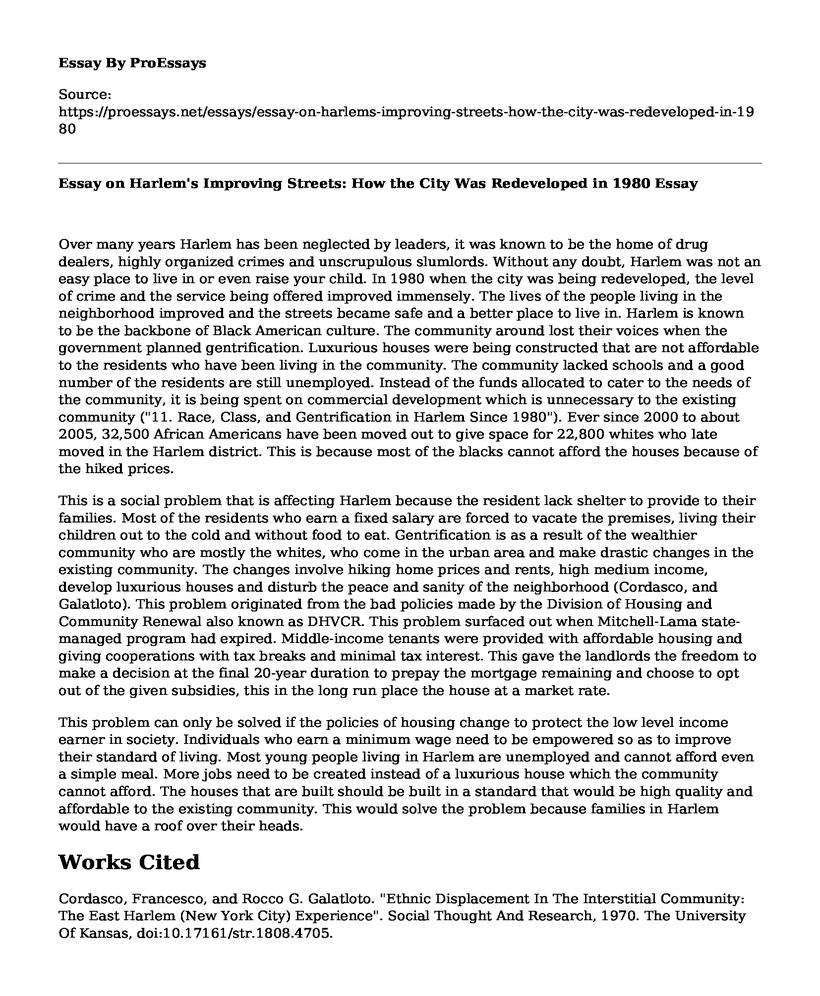Over many years Harlem has been neglected by leaders, it was known to be the home of drug dealers, highly organized crimes and unscrupulous slumlords. Without any doubt, Harlem was not an easy place to live in or even raise your child. In 1980 when the city was being redeveloped, the level of crime and the service being offered improved immensely. The lives of the people living in the neighborhood improved and the streets became safe and a better place to live in. Harlem is known to be the backbone of Black American culture. The community around lost their voices when the government planned gentrification. Luxurious houses were being constructed that are not affordable to the residents who have been living in the community. The community lacked schools and a good number of the residents are still unemployed. Instead of the funds allocated to cater to the needs of the community, it is being spent on commercial development which is unnecessary to the existing community ("11. Race, Class, and Gentrification in Harlem Since 1980"). Ever since 2000 to about 2005, 32,500 African Americans have been moved out to give space for 22,800 whites who late moved in the Harlem district. This is because most of the blacks cannot afford the houses because of the hiked prices.
This is a social problem that is affecting Harlem because the resident lack shelter to provide to their families. Most of the residents who earn a fixed salary are forced to vacate the premises, living their children out to the cold and without food to eat. Gentrification is as a result of the wealthier community who are mostly the whites, who come in the urban area and make drastic changes in the existing community. The changes involve hiking home prices and rents, high medium income, develop luxurious houses and disturb the peace and sanity of the neighborhood (Cordasco, and Galatloto). This problem originated from the bad policies made by the Division of Housing and Community Renewal also known as DHVCR. This problem surfaced out when Mitchell-Lama state-managed program had expired. Middle-income tenants were provided with affordable housing and giving cooperations with tax breaks and minimal tax interest. This gave the landlords the freedom to make a decision at the final 20-year duration to prepay the mortgage remaining and choose to opt out of the given subsidies, this in the long run place the house at a market rate.
This problem can only be solved if the policies of housing change to protect the low level income earner in society. Individuals who earn a minimum wage need to be empowered so as to improve their standard of living. Most young people living in Harlem are unemployed and cannot afford even a simple meal. More jobs need to be created instead of a luxurious house which the community cannot afford. The houses that are built should be built in a standard that would be high quality and affordable to the existing community. This would solve the problem because families in Harlem would have a roof over their heads.
Works Cited
Cordasco, Francesco, and Rocco G. Galatloto. "Ethnic Displacement In The Interstitial Community: The East Harlem (New York City) Experience". Social Thought And Research, 1970. The University Of Kansas, doi:10.17161/str.1808.4705.
"11. Race, Class, and Gentrification in Harlem Since 1980." Race Capital?, 2018, pp. 243-266.
Cite this page
Essay on Harlem's Improving Streets: How the City Was Redeveloped in 1980. (2022, Dec 29). Retrieved from https://proessays.net/essays/essay-on-harlems-improving-streets-how-the-city-was-redeveloped-in-1980
If you are the original author of this essay and no longer wish to have it published on the ProEssays website, please click below to request its removal:
- Essay Sample on Vernacular Music of the United States
- Profile Essay on the Egyptian Pyramids
- Essay Sample on Declaration of Independence: Birth of US Freedom
- Essay Sample on French Declaration of War on England Tests US Neutrality
- Essay Example on Holocaust: Atrocity, Anguish, & Senseless Mass Murder
- Essay Sample on Privacy Policy: Understanding How Your Data is Protected
- Essay Example on Roman Influence







